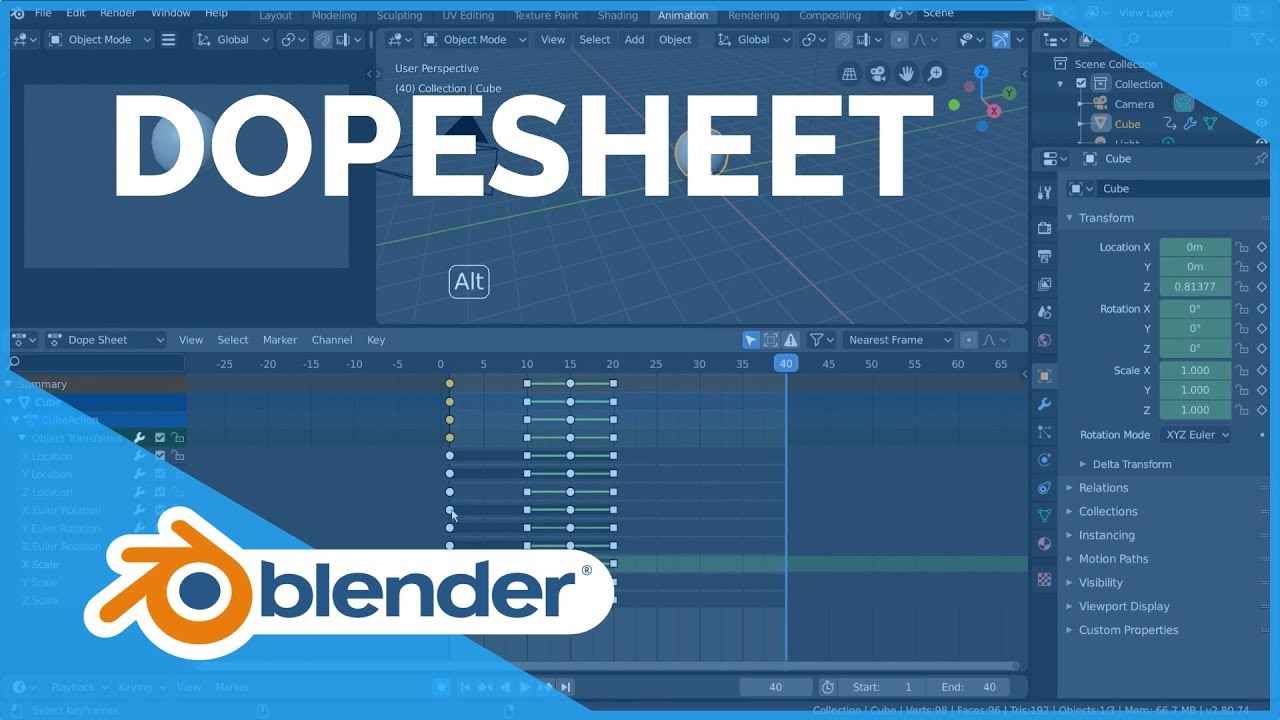i keep hearing it is but i cant find anything useful about it. i checked youtube, i googled it, i asked on the reddit 3 times and all peopletold me was “it has extra features and is more advanced.”
witch didnt help at all. i want to why i sould use it or atleast at the bare minimum what some of the features are
im still confused. i still dont understand its uses.
it just looks like a timeline with extra steps
Hello,
‘a timeline with extra steps’
seems correct. As far as i used it , it’s useful for mixing several movements , and also to see them as key elements to compose with.
Timeline is better for simple stuff while the dopesheet is better for more complex stuff.
It’s a helpful way to see what is animated in the scene. It also give you an easy way to retime actions effecting multiple objects.
Since 2.8, developers introduced a concept of fake editor.
An generic editor is declined with a different UI for specific purpose.
In 2.79, there was only one node editor.
Now, there are a Compositor, a Texture Node Editor, a Geometry Node Editor and a Shader Node editor.
Same thing happened with Timeline and Dopesheet.
In 2.79, keyframes were not editable in Timeline. But people was asking for that.
So, in 2.8, Timeline became a Dopesheet with a different header.
So, differences are mainly what is available from header of editor.
Timeline is the editor where you set settings for Playback and that contains playback buttons.
Dopesheet was originally the only editor to handle keyframes manipulations.
So, menus about that (Select, Channel, Key) are just available in Dopesheet.
There are more filters options in Dopesheet.
And Dopesheet editor is offering different display modes.
So, that is not really one editor instead of the other. To animate, you need to use both editors.
I think that current UI is a little bit stupid about that.
IMHO, those editors should be merged into a unique one.
I would change Timeline Header into a Dopesheet footer.
but like what complex stuff. im still realy confused of whys its better. what features does it have?
huh? im confused
but i already know what animated in the scene. i only animate one ting at a time. i usuay just animate one single person.
Then you might not need it. But if you have a character pick up an object or open a door or interact with another character, it can be handy. If it’s not useful to you, don’t use it. But knowing what it is useful for could help you in the future.
im lteraly here asking what it does. not when to use it.
Things you can do with a dope sheet that you can’t do with a timeline: filter channels and objects; show unselected objects; adjust keyframes for independent channels; set extrapolation, easing. You can also change to a dope sheet-as-action-editor (or other editors too, but I never use those), which has other options, notably the ability to change or stash the active action.
Things you can do with a timeline that you can’t do with a dope sheet: change start and end frame of animation; fast forward or rewind; set playback options such as sync, and keying sets.
There is enough overlap that, for me, I find it frustrating that there isn’t an editor with the features of both, but it is what it is.
The best way to think about this is in terms of having more fine/detailed control of your animation.
For a high-level understanding of where your keyframes are, the Timeline is more than enough to get you what you need… this is particularly true if your just doing simple object or camera animation. However, when you get to the point where you have a more complex rig with lots of moving parts, you’re going to want to have a better sense of what’s been keyed when.
That’s where the Dopesheet is useful. The Timeline shows any keyframe (well, mostly any keyframe, but let’s not get distracted). The Dopesheet, on the other hand, shows keyframes on a per object or sub-object (like in an Armature) level so you can better coordinate timing between different elements of your animation.
And, of course, even that may not be enough detailed information for some animations. That’s when you dive even deeper and go to the Graph Editor. That’s going to give you a very detailed understanding of the movement of just a handful of objects (by default, just the ones you currently have selected.
Basically, think of these editors as a set of concentric circles (like a target) from Timeline > Dope Sheet > Graph Editor. As you get closer to the center of those circles, the more granular detail and control you have.
ok im play around with dope sheet a bit. still kinda confused.i dont really understand what the other key frame types do. or if they even have an effect.
also very confused by the graph editor.
this stuffs reallly confusing. i dnt understand what most of the terms mean.
It sounds to me like you could really use some entry level training on Blender’s animation workflow… and perhaps a few other Blender basics in general. I don’t want to be too much of a shill for my own work, but if you’re the sort of person who benefits from books, I did write a book that may be able to provide you with what you need. Alternatively, there are quite a few really decent video tutorial series’ on animating in Blender by folks in the community that you may find useful.
i played around a bit a figured it out. also tried the graph editor and have a rough idea of that. i mainly want to know what the differant keyframe types do. like vector etc. just kinda curious of what difference those make in the long run.
